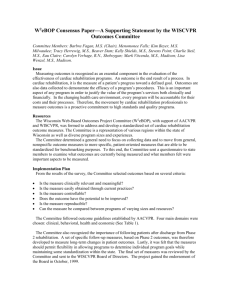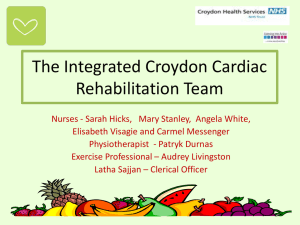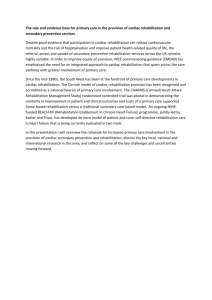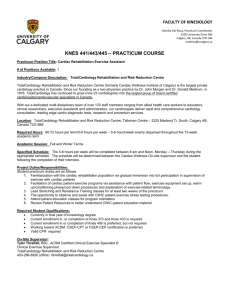ACGReport March2015 - Angus Cardiac Group
advertisement
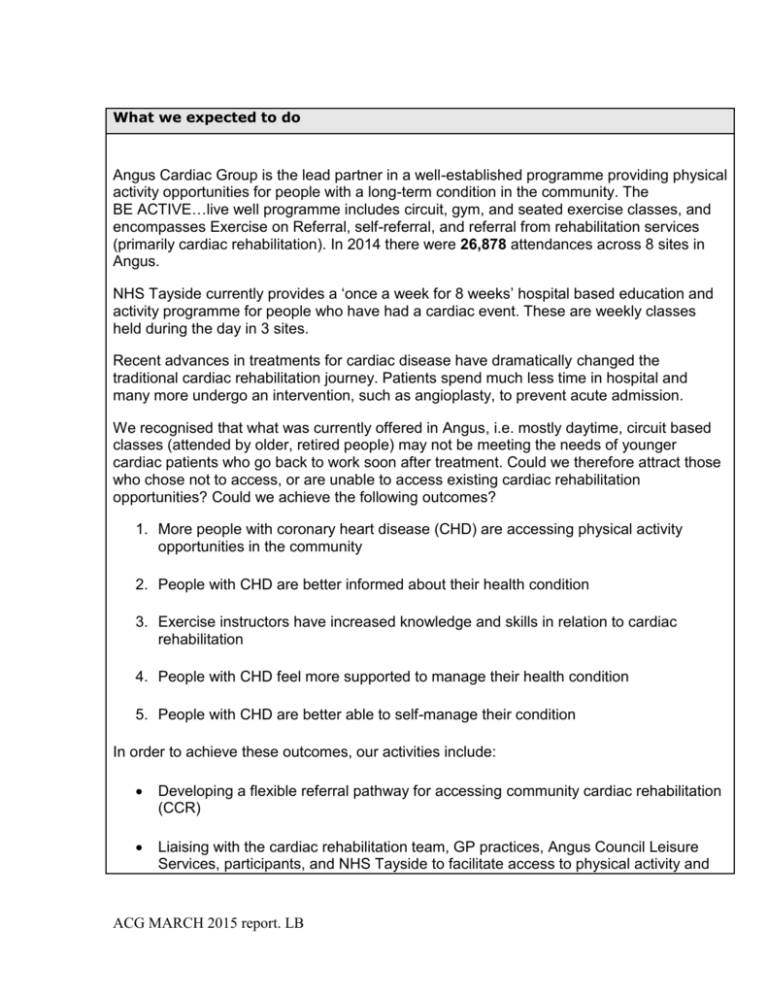
What we expected to do Angus Cardiac Group is the lead partner in a well-established programme providing physical activity opportunities for people with a long-term condition in the community. The BE ACTIVE…live well programme includes circuit, gym, and seated exercise classes, and encompasses Exercise on Referral, self-referral, and referral from rehabilitation services (primarily cardiac rehabilitation). In 2014 there were 26,878 attendances across 8 sites in Angus. NHS Tayside currently provides a ‘once a week for 8 weeks’ hospital based education and activity programme for people who have had a cardiac event. These are weekly classes held during the day in 3 sites. Recent advances in treatments for cardiac disease have dramatically changed the traditional cardiac rehabilitation journey. Patients spend much less time in hospital and many more undergo an intervention, such as angioplasty, to prevent acute admission. We recognised that what was currently offered in Angus, i.e. mostly daytime, circuit based classes (attended by older, retired people) may not be meeting the needs of younger cardiac patients who go back to work soon after treatment. Could we therefore attract those who chose not to access, or are unable to access existing cardiac rehabilitation opportunities? Could we achieve the following outcomes? 1. More people with coronary heart disease (CHD) are accessing physical activity opportunities in the community 2. People with CHD are better informed about their health condition 3. Exercise instructors have increased knowledge and skills in relation to cardiac rehabilitation 4. People with CHD feel more supported to manage their health condition 5. People with CHD are better able to self-manage their condition In order to achieve these outcomes, our activities include: Developing a flexible referral pathway for accessing community cardiac rehabilitation (CCR) Liaising with the cardiac rehabilitation team, GP practices, Angus Council Leisure Services, participants, and NHS Tayside to facilitate access to physical activity and ACG MARCH 2015 report. LB education Piloting evening exercise classes in local leisure centres Piloting new ways of delivering group education classes on a range of topics related to managing CHD Providing 1-1 gym inductions and programmes Providing training and support to community based exercise instructors Providing 8 initial sessions free of charge within leisure centres for new participants, to encourage attendance Promoting the benefits of cardiac rehabilitation within the community What we actually did Over the 6 month period from October 2014 to March 2015, we have achieved the following: As from the project’s inception, we continued with regular management group meetings to direct our activities Our 8 session free pass is being given to new participants. 30 passes have been issued since the project started In total, 33 people have benefitted to date. The variety of paths taken by these participants is shown appendix 1. This demonstrates the flexibility in what we are offering, and that a person centred approach can be offered Development of a new flyer to encourage elective PCI patients to participate in a programme of cardiac rehabilitation (see appendix 2). Letters go out to these patients from Ninewells hospital to invite participants to the hospital based rehabilitation. The cardiac rehabilitation team agreed to include our flyer in order to offer patients the choice to also exercise in the community. Latest figures are that 9 letters have been sent with 1 person contacting the service. Following assessment he was then referred for a 1-1 gym programme Exercise instructor study session in December (see appendix 3). 7 blood pressure monitors were purchased to give to exercise instructors and a workshop on the use of these formed the basis of this study session. It was also an opportunity for exercise ACG MARCH 2015 report. LB instructors to get together and a chance to acknowledge their contribution to the project Following on from the study session, the cardiac rehabilitation support nurses (CRSN) led 8 self-management sessions at community exercise classes. These sessions educated participants regarding targets for and measuring blood pressure, pulse, BMI and waist measurement. In total 82 people attended Blood pressure record cards have been produced (see appendix 4). These are used by participants in the classes to promote ‘know your numbers’ and facilitate selfmanagement. These have also been distributed to GP surgeries to promote the project New evening gym class in Forfar for cardiac participants Supported establishment of a new seated exercise class in the village of Friockheim led by a BACPR qualified instructor A further 1 exercise instructor is being supported to gain the prerequisites for BACPR enrolment later this year, adding to the 2 that the project already supports Three project personnel attended a 1 day BACPR ‘Monitoring Exercise Intensity’ course. 6 exercise instructors attended a 2 day BACPR ‘Physical Activity & Exercise in the Management of Cardiovascular Disease Part II: Advanced Application’. Follow up will take place at a study session planned in May to assess what difference this training has made to practice, and what further support is required Education talks have taken place at Forfar branch meetings of ACG on three topicsnutrition, medication, and heart health. Beneficiaries were 18, 22, 18 respectively What difference we actually made Participants in the project are asked to complete 3 questionnaires (see ‘How we collected the information’ below) to assess to what extent we are meeting our stated outcome measures. Numbers attending self-management sessions with the CRSN were recorded, as well as any resulting feedback or outcomes. At present, we are able to report on 13 participants who have provided information using the Patient Feedback Questionnaire. The following is illustrative of the difference we are making: Of the beneficiaries of the free passes followed up so far, we can report a high completion rate- 92% have claimed all 8 sessions ‘Very well supported. She [the exercise instructor] noticed the giddiness and toppling forward when standing up and notified the Nurse who checked my blood pressure and advised me to see my GP that same day’ ‘The classes are well worthwhile. Apart from the extra exercise received, seeing how others, who have been affected to a much worse degree than oneself, are coping and ACG MARCH 2015 report. LB progressing both physically and mentally is most encouraging and gratifying’ ‘Phase 3 [hospital based] exercise programme too sedentary for person with 35 year background of running, cycling and tai chi’ The self-management sessions were well received with feedback such as: ‘Learnt more in 15 minutes from CRSN than in years from all the doctors’ ‘Very easy to do myself after being taught how’ In 2 cases an irregular pulse was detected and the participants directed to their GPs for investigation. A further one person had symptomatic hypotension detected and was also advised to contact their GP. Challenges and changes Recruiting new participants to the programme This is an ongoing challenge. We had hoped that GP surgeries would identify suitable patients but despite visits and emails to promote the project in our target areas (Brechin and Forfar) this has not generated referrals. We assume that this is due to lack of time capacity within the practices to do this, but this needs explored further. Our next activity to recruit people is to produce posters which will go out to all GP practices, out-patient departments, leisure centres, libraries etc. in Angus to appeal directly to potential participants. The draft poster is attached as appendix 5. Although we feel current recruitment is low (33 people to date), this does need to be put in the context of how many people are accessing community cardiac rehabilitation overall. From October 2013 to March 2015, there were a total of 136 new cardiac participants into community classes. This includes the 33 directly associated with the project. Therefore, 24% of new participants are benefitting from the new opportunities offered by the project. Because of the problems with recruitment as described above, the new evening gym class in Forfar has needed extra support. We want to ensure that the class is kept running long enough to allow time for new people to be recruited. We have therefore allowed existing cardiac participants, as well as some non-cardiac participants to attend for the 8 sessions. Because attendees haven’t been ‘new’ cardiac participants, the CRSN no longer attends but when this changes, she will be available to offer support. Learning for the future Evaluation ACG MARCH 2015 report. LB There are a number of things we will do differently in our evaluation due to experiences so far: Currently the CRSN is following up at 8 weeks. However it would be better to do this after 12 weeks to allow for holidays/illness as we are finding that many people do not complete all sessions within 8 weeks. It will also be useful to follow up after this to see how many people continue to participate in physical activity after their 8 free sessions. We will look into how this can be achieved Data quality is reduced when postal questionnaires are given- reduced feedback and not always returned. Although more time consuming, face-to-face feedback should be sought where possible Our quantitative evaluation needs reviewed. Return rates on pre- and postquestionnaires have been low. The Wellbeing Evaluation Questionnaire seems to have been poorly understood by some participants, and may not be an appropriate tool in its current form or may need to be given out with some verbal explanation How we collected the information New participants are assessed either by our CRSN or by NHS Cardiac Rehabilitation Staff according to established protocols. We have 3 questionnaires to assess the difference we are making (all included in the September 2014 report): Outcome Evaluation Questionnaire. We ask participants to complete this before they start the programme (if no prior cardiac rehabilitation input), and after 8 weeks Wellbeing Evaluation Questionnaire. This is completed before they start the programme (with or without previous cardiac rehabilitation input), and after 8 weeks Patient Feedback Questionnaire. We ask participants to complete this in conjunction with the CRSN at the 8 week follow up meeting How we spent the money Details of the expenditure are included below (appendix 6). The actual spend to date (for 18 months of funding), actual 6 month spend, and the projected 6 month spend (to include March 2015 spend) is shown. We have spent 80% of our total funding to date. We expect that for the period October 2014 to March 2015 we will have achieved 97% spend from that £21,695 payment. We therefore have only a small underspend from this 6 month reporting period. However, due to factors explained in this and in previous reports (lower numbers recruited to project than anticipated and consequent delay in requiring a second CRSN), we do have an ongoing underspend. ACG MARCH 2015 report. LB This is estimated at £9,825. Areas that show significant variances from the budget are: Time: Our overall time costs still show an underspend due to the delay in our second CRSN starting, and there being fewer new participants to support. We will also have to make adjustments for the final 6 months because our original CRSN is due to leave the project in mid-April. Training: Supporting the new CRSN to undertake the course ‘Current Perspectives in Cardiac Care’ is resulting in higher costs than anticipated due to the study time involved. However this training will be of considerable benefit to the project and we anticipate that it will also benefit community cardiac rehabilitation provision in the long term. Timely access to training has always been an issue for us (suitable training courses take place in Scotland more infrequently than we would like). Therefore we have been taking advantage of online courses, and have put another BACPR instructor on the level 3 Exercise Referral course. This will broaden that instructor’s knowledge of additional clinical conditions that cardiac participants may have. Research has shown that people with severe mental health problems are two to three times more likely to suffer from cardiovascular disease due to medication and lifestyle factors (https://www.bhf.org.uk/heart-health/preventing-heart-disease/heart-and-mental-health). We decided that some of our underspend should be reallocated to pay for one of the BACPR instructors (who is also the Project Coordinator) to go on the Level 4 course Exercise and Mental Health. This was seen as a good opportunity to assess the usefulness of this training for our programme in the future, but also key learning can be shared at future exercise instructor study sessions. We will also consider funding further training for our BACPR instructors (e.g. ACPICR ‘Principles and Applications of Resistance Training for Health Care Professionals in Cardiac Rehabilitation’) as an appropriate use of any underspend. Pilot Courses: It is likely that we have overestimated the numbers that will take up the 8 free sessions. However we will retain the allocation for this in the budget as we still hope to recruit more people with ongoing promotion and advertising. But we will review this monthly. Appendices Appendix 1: Pathways of beneficiaries accessing community physical activity Appendix 2: Flyer to promote project to Ninewells elective PCI patients Appendix 3: Programme for Exercise Instructor Study Session, December 2014 ACG MARCH 2015 report. LB Appendix 4: Blood Pressure Record Card Appendix 5: Poster advertising programme Appendix 6: Budget & expenditure summary ACG MARCH 2015 report. LB Appendix 1: Pathways of beneficiaries accessing community physical activity Exercise type Route of entry Self-referral Immediate entry (no phase 3) Early entry (before completing phase 3) Concurrent with phase 3 After completing phase 3 Concurrent recruitment to Heart Failure Project Private gym Circuit Class 1-1 gym programme Seated exercise Gym class 2 4 4 3 2 1 1 2 3 ACG MARCH 2015 report. LB 7 4 Appendix 6: Budget and expenditure summary BUDGET Alliance Funding Time Travel Training & Development : Training Travel & Accommodation Equipment Pilot Courses Promotion Monitoring & Evaluation Administration & Documentation ACTUAL 18 Month SPEND TO 10/03/15 6 MONTHS PROJECTED SPEND TO 31/03/15 £65,085 £65,085 £21,695 £21,695 37386 6035 27564 5124 9518 2128 12032 2583 3360 4204 7402 1450 2574 45 3169 145 6125 2160 3475 600 1740 5265 523 2816 0 1631 472 322 1684 0 796 1632 473 572 0 418 65085 51775 80% Spend 17539 81% Spend 21024 97% Spend £0 £13,310 £4,156 £671 Underspend March 15 Projection Spend £3,485 Projected 18mth Underspend @ 31 March 2015 £9,825 ACG MARCH 2015 report. LB 6 MONTHS ACTUAL SPEND TO 10/03/15
